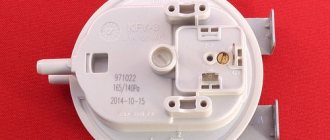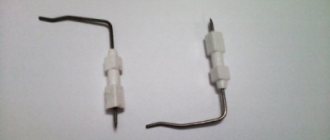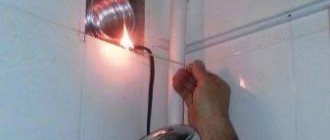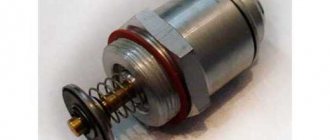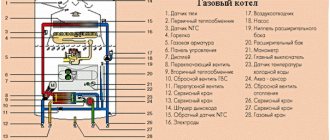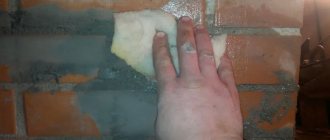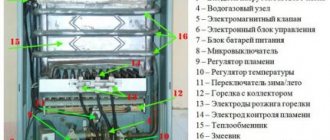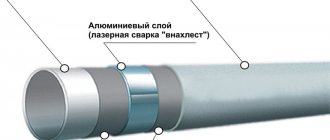The geyser is very popular among owners of apartments and private houses. Of course, the device does an excellent job of providing residents with hot water, does not require complex maintenance, and the cost of fuel used is minimal. But the water heater also has one serious drawback - a gas leak can lead to an explosion, destruction of the house and death. Therefore, it is extremely important to identify a breakdown in a timely manner and know how to check the draft in a gas water heater at home.
Each element of the device must work flawlessly, any problems must be corrected immediately, and failed parts must be immediately replaced. Regular checks of the system are carried out by gas service specialists, but you can periodically inspect some elements on which the safety of people living in the house depends on yourself.
We will try to figure out how to test the design, in particular, check the draft of the water heater, at home. In the article we will also consider effective ways to combat the lack of draft in the smoke duct.
The principle of operation of the chimney
A chimney is necessary not only for a stove or fireplace; if you have a gas water heater installed in your house, then the presence of a chimney pipe is also a prerequisite. The chimney itself is a means through which exhaust gases generated during the combustion process are removed. If it is not there, then they begin to enter the living space. This is simply unacceptable, since a person can easily be poisoned by carbon monoxide, which is formed after the combustion of fuel or gas. (See also: How to clean a chimney pipe)
In order to prevent even a gram of exhaust gases from entering the living space, the chimney must have very good draft, due to which all waste harmful substances enter the pipe.
There is a special device called an anemometer to measure draft. Its cost is quite high. It is usually used by gas service specialists when they begin checking chimneys in apartments or private houses. For individual use, buying such a device is frankly quite expensive. In addition, you can use other methods to determine the presence of draft in the chimney.
Usually, ordinary paper is used for this, which is set on fire and brought to the chimney grate. If there is draft, the flame will deviate towards the chimney. You can also use matches instead of paper. (See also: Sitemap 2)
Traction problems
In order to determine the presence of good draft in a pipe, it is not necessary to have a special device. Sometimes the problems that arise acquire such a large scale that it is not difficult to determine the complete absence of gases escaping from the room.
As a rule, the following indicates a malfunction of the outlet pipe:
- If you look closely at the color of the flame while lighting a stove or fireplace, you can talk about the following. Insufficient draft power is indicated by a dark red flame in the firebox.
- The bright, almost white color of the burning fuel, on the contrary, indicates a strong thrust.
- If you smell smoke in the room, this may indicate a malfunction of the chimney and a complete lack of draft; this effect is called reverse draft. In this case, all the smoke and waste combustion products do not end up outside, but, on the contrary, into the room.
(See also: How to clean soot from a chimney)
Reasons for the malfunction of the chimney pipe
During ideal operation of the chimney, the flame in the firebox of the stove or fireplace usually has a golden color, there is no extraneous noise in the chimney, and there is no smell of smoke in the room. The reasons for the malfunction of the smoke exhaust system are mainly the following:
- Mistakes at the initial stages of design. Perhaps the chimney is of insufficient size and simply cannot cope with the incoming flow of waste substances.
- It is possible that the wrong pipe height is selected, which can also significantly affect the operation of the chimney.
(See also: Exhaust pipes for gas boilers)
The first two cases are relevant when, when you first start a gas water heater or fire a furnace, it shows that there is no draft in the chimney. And if you previously lit a stove or fireplace and there were no problems with the removal of exhaust gases, then the reasons that affected the draft may be the following.
- Temperature difference too large.
- Blockages in the chimney.
- The presence of a large amount of soot in the chimney.
- Weather conditions: strong, gusty winds or high humidity due to prolonged precipitation.
Sometimes, due to high humidity at the beginning of lighting a fireplace or stove, draft may be completely absent. As a rule, this state of affairs is temporary. After some time, when the inner surface of the pipe dries out slightly, the draft will quickly recover and all the smoke that has entered the room will instantly disappear. (See also: How to clean a gas boiler chimney)
Automation of a gas heating boiler
There are special rules for the operation of gas equipment. This document states that any gas-powered unit must be equipped with automatic safety equipment. Her tasks include:
- detection of characteristics that deviate from normative ones;
- processing the received data and transmitting a signal to the actuator, which turns off the fuel supply;
- turning on an alarm (light or sound), which will notify you that the gas boiler is turned off.
In addition to the draft sensor, the gas boiler safety system includes:
- Temperature sensor for coolant. It controls the temperature of the water inside the heating system. When the latter increases, the gas supply is turned off.
- Coolant pressure sensor. Its task is to control the operation of the circulation pump.
- Fire torch sensor. He is responsible for the presence of the torch. That is, if the last one goes out, the boiler turns off completely, because gas cannot be allowed to leak into the room.
- Temperature sensor for the air surrounding the boiler.
Temperature and draft sensor inside the boiler unit
How to fix the situation
If checking the draft in the chimney shows its complete absence or poor quality, you will have to make a certain decision so as not to be left without heat in bad weather.
In general, ideally, a special device is installed in the chimney pipe - a chimney draft regulator. It helps maintain the pressure required by building codes in the flue gas system. This in turn eliminates the incorrect operation of the system as a whole. If necessary, the regulator can either reduce or increase the exhaust gas exhaust force in the pipe.
So, such a device is useful for prevention, and what to do when the chimney pipe can no longer cope with the load or, as it turns out, was designed incorrectly. Then all that remains is to correct the errors and do it as soon as possible.
Therefore, using a fireplace or stove if the chimney is not working correctly is simply prohibited. Carbon monoxide may not be noticed at all. Sometimes a headache just starts and drowsiness appears; a person can lie down for a while and inhale toxic substances.
If we talk about the height of the pipe, then in accordance with established standards, its size directly depends on the slope of the roof. If the height of the pipe does not correspond to the given parameters, it will have to be increased. According to established standards, it is allowed to arrange the height of the pipe a little more, but not less than the established standards.
Just be sure to take into account the fact that sooner or later the pipe will have to be cleaned. Maybe you will do it yourself, or maybe you will use the services of a specialist, it doesn’t matter. Just remember that a pipe that is too tall will be impossible to clean properly.
Functionality check
If problems are observed in the operation of the boiler, the sensor may need to be replaced. For example, if the burner is regularly turned off, but no problems are observed in the combustion gas exhaust system. You also need to check the operation of the device when it periodically turns off after 20-30 minutes.
To check the serviceability of the boiler sensor, you need to consider 3 methods:
- Attach a regular mirror near the device. If the sensor is operating normally, then the surface of the mirror should not be covered with condensation.
- A simple way to check by partially blocking the chimney. A working sensor will promptly give a signal and the equipment will turn off.
- If a double-circuit boiler is used as heating equipment, then to check the device you can switch it to DHW mode, without heat supply. Then open the tap to a powerful stream of water. Here the situation is the opposite - turning off the sensor will be a sign of its problematic operation.
There are many manufacturers of traction sensors. Among them are such market leaders as Junkers, KAPE, Sitgroup, Eurosit. Some boiler manufacturers (Baxi, Danko) produce devices for their heating equipment. It is necessary to select the correct sensors for the equipment that is used (gas water heaters, wall-mounted or floor-standing boilers). It is important to periodically check the serviceability of the boiler draft sensor.
Increased traction
If checking the chimney draft showed its complete absence or small value. You can also use a device such as a chimney draft stabilizer or turbine. True, their use is limited only to gas boilers. Too high a temperature of the exhaust gases at the outlet of the pipe will contribute to improper operation of the device or its failure.
If we talk about stoves or fireplaces, then in order for the chimney to work correctly during not very good weather conditions. Special tips - wings - are installed on the pipe. This device rotates freely so that its back is always facing the wind. This position prevents wind or rain from entering directly into the chimney.
Special fans can also be used. Such devices have a built-in electric motor. Their operating principle is as follows. Basically, they work from the wind; during strong gusts, the fan rotates, increasing the release of exhaust gases from the pipe; if the wind flows are not strong enough, then the electric motor turns on, which forces the fan to work forcibly and all harmful substances also end up on the street.
A small disclaimer: do not immediately after reading the article run to the store and buy a new device. Before you are going to install it, you should make calculations. And based on the results obtained, it will be clear whether this device can be installed on your chimney.
If there is no draft in the chimney, it will be useful to check the operation of the dampers. For stoves and fireplaces, this is a kind of regulator of the exhaust gas removal force.
Reasons for triggering
The reason for the operation of the automatic control system can be various problems in the installation of the smoke exhaust structure, or failures of the sensor parameters themselves.
Flue gas safety thermostat 70 °C
Let's look at the most common ones:
- Strong wind. A gust of wind may blow out the gas burner. To prevent this from happening, purchase a stabilizer for the unit and install it in place of the outlet pipe.
- Clogged chimney system. In this case, cleaning will be required.
- Weak traction parameters. The draft sensor of a gas boiler reacts when heated to 950-1500 °C. Due to the difficulty of removing smoke, overheating occurs inside the smoke removal system and the gas valve turns off.
- Incorrect installation of gas equipment.
- Incorrect calculation of chimney dimensions. The height of the chimney is measured depending on the distance of the pipe from the roof ridge. The recommended location is exactly in the center of the roof. In this case, the head will rise above the ridge by more than half a meter.
